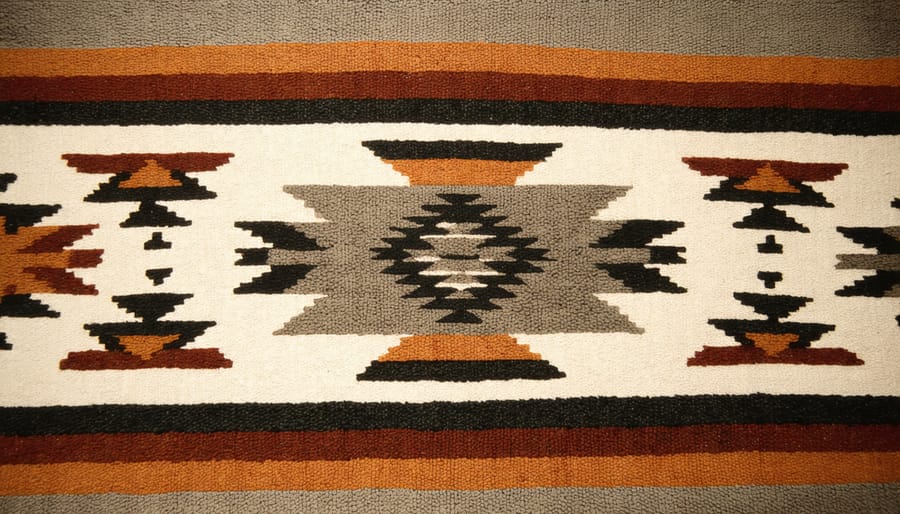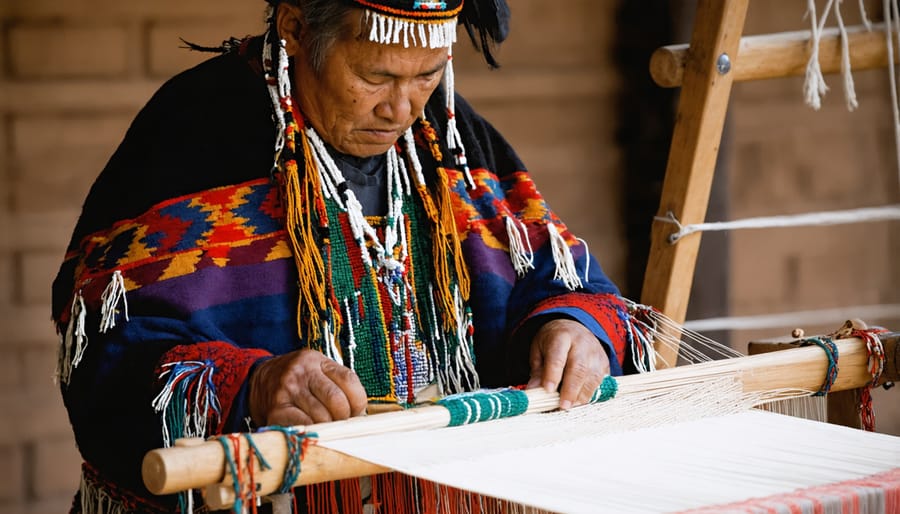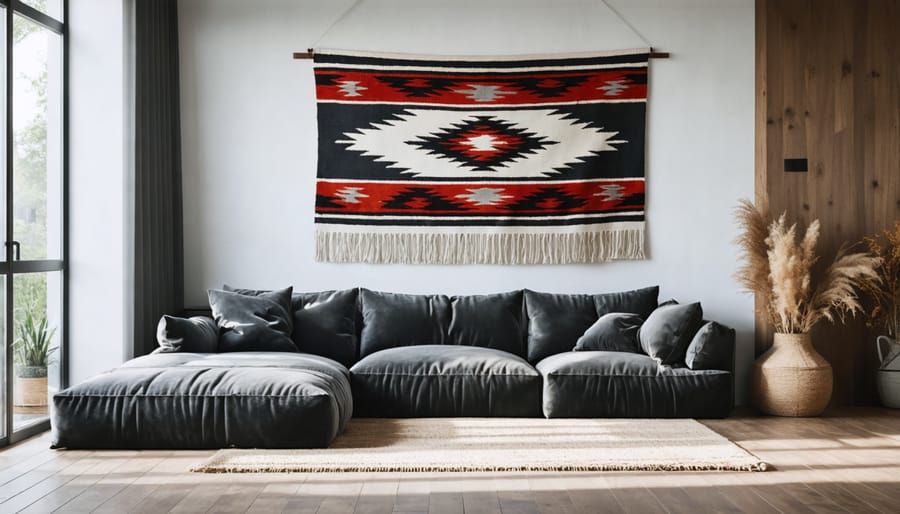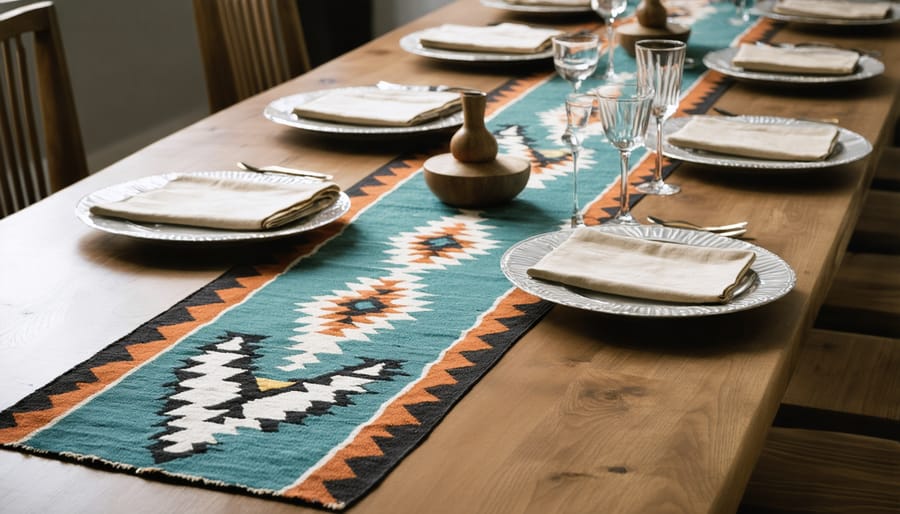Transform your living space with the timeless artistry of ancient weaving techniques perfected by Navajo masters over centuries. The distinctive geometric patterns, rich earth tones, and intricate weaving methods of Navajo textiles tell stories of cultural heritage while creating stunning focal points in contemporary homes.
Beyond their aesthetic appeal, Navajo weaving techniques represent a sophisticated system of mathematical precision and artistic innovation. Each pattern carries deep symbolic meaning, from the sacred Four Corners motifs to the lightning designs that dance across ceremonial blankets. These time-honored methods combine hand-spun wool, natural dyes, and precise tension control to create textiles that can last for generations.
Today’s artisans preserve these traditional techniques while adapting them for modern applications, from statement wall hangings to architectural installations. Whether you’re a design enthusiast or a cultural preservationist, understanding Navajo weaving opens doors to a world where functionality meets profound artistic expression. The following guide explores essential Navajo weaving methods, their cultural significance, and practical applications in contemporary design spaces.
The Spiritual and Cultural Foundation of Navajo Weaving
Sacred Symbols in Navajo Designs
In modern home decor, Navajo symbols carry deep cultural significance while adding meaningful beauty to your living spaces. The spiral, a common motif, represents the journey of life and continuous growth – perfect for spaces where you seek inspiration, like home offices or meditation corners. The four sacred mountains symbol, depicted as triangular shapes, brings balance and protection, making it ideal for entryways and living rooms.
Lightning patterns, characterized by zigzag lines, symbolize power and swiftness, adding dynamic energy to contemporary spaces. These work particularly well in active areas like family rooms or exercise spaces. The diamond pattern, representing the four cardinal directions, brings harmony and can anchor a room’s design scheme, especially in larger spaces like dining rooms or master bedrooms.
When incorporating these symbols into your home, consider their placement thoughtfully. Spirit line designs, which appear as intentional imperfections, remind us that nothing is perfect – a comforting message in any room. The water symbol, shown as parallel lines with dots, represents flow and cleansing energy, making it particularly suitable for bathrooms or spa-like spaces.
Remember that these symbols aren’t just decorative elements – they’re sacred cultural expressions. Choose pieces that resonate with your space while respecting their traditional significance. Consider starting with smaller accent pieces like throw pillows or wall hangings to tastefully integrate these meaningful designs into your home.

Color Significance in Traditional Patterns
The colors used in traditional Navajo weaving tell stories that can transform modern living spaces. These time-honored combinations, rooted in natural dyeing traditions, offer a rich palette that works surprisingly well in contemporary interiors.
Earth tones like deep browns, warm terracottas, and sandy beiges form the foundation of many traditional patterns, creating a grounding effect that can make any room feel more balanced and welcoming. These colors work particularly well in living rooms and entryways, where they create an immediate sense of warmth and connection to nature.
The deep reds often found in Navajo textiles symbolize sunlight and life force, making them perfect accent colors for spaces where you want to encourage energy and conversation. Meanwhile, the blacks and dark grays represent protection and the night sky, offering sophisticated neutral options for modern spaces.
Blues and greens, representing water and plant life, can bring a sense of tranquility to bedrooms and reading nooks. When combined with traditional geometric patterns, these colors create a perfect balance between cultural authenticity and contemporary style.
To incorporate these colors effectively, start with a neutral base and layer in two or three traditional Navajo hues through textiles, artwork, or accent pieces. This approach honors the cultural significance while creating a fresh, modern look that feels both timeless and personal.
Essential Navajo Weaving Techniques

The Upright Loom Method
The heart of traditional Navajo weaving lies in the upright loom, a simple yet ingenious tool that has remained largely unchanged for centuries. This vertical wooden frame typically stands between five and six feet tall, constructed from sturdy wooden beams that create a rectangular structure. Two horizontal beams, known as the top and bottom beams, hold the warp threads in place, while side supports ensure stability during the weaving process.
Setting up the loom begins with the careful installation of the warp threads, which run vertically from top to bottom. These threads create the foundation of your weaving and must be pulled taut with consistent tension. Traditional weavers use a continuous warping method, where a single long thread is wrapped around the beams in a figure-eight pattern, creating parallel lines that will guide your weaving.
Essential tools for the upright loom method include a batten (a flat wooden tool used to pack down weft threads), various sizes of weaving combs, and a shuttle to carry your weft yarn across the warp threads. Modern weavers often incorporate a threading hook and scissors, though traditionally, these tools would have been made from natural materials.
The beauty of the upright loom lies in its versatility and portability. You can adjust the tension of your weaving by simply moving the bottom beam, and the vertical orientation allows you to see your entire project as it develops. This visibility is crucial when creating complex patterns and ensures symmetry in your design.
For beginners, starting with a smaller loom (around three feet tall) can make the learning process more manageable. The key is to maintain consistent tension in both your warp and weft threads, as this will determine the quality and durability of your finished piece. Remember, the upright loom method isn’t just about the tools – it’s about developing a rhythm and understanding how each element works together to create beautiful, lasting textiles.
Basic Pattern Creation
Creating basic Navajo-inspired patterns starts with understanding the fundamental elements that make these designs so distinctive. Begin by selecting a simple geometric shape, such as a diamond or triangle, which are common in traditional Navajo weaving. Using graph paper can help you plan your pattern before starting the actual weaving process.
Start with a basic diamond pattern:
1. Draw a center point on your graph paper
2. Create four equal lines extending outward at 45-degree angles
3. Connect these lines to form a diamond shape
4. Add parallel lines inside the diamond to create depth
For a step design:
1. Begin with a straight horizontal line
2. Create equal-sized squares moving upward
3. Connect the squares to form a stepped pattern
4. Repeat the pattern to create a flowing design
Traditional Navajo patterns often incorporate these basic elements:
– Horizontal lines representing the earth
– Vertical lines symbolizing rain
– Diagonal lines depicting lightning
– Zigzag patterns representing mountains
When choosing colors, start with a simple palette of three to four hues. Earth tones like rust red, deep brown, and natural cream are traditional choices that work well together. As you become more comfortable with basic patterns, experiment with:
– Mirroring your designs
– Creating repeated motifs
– Combining different geometric shapes
– Adding secondary patterns within larger ones
Remember to maintain symmetry and balance in your design, a key principle in Navajo weaving. Start small and gradually increase complexity as your confidence grows. Practice each pattern multiple times before moving on to more intricate designs, ensuring your foundation is solid before advancing to more complex techniques.
Keep your first attempts simple and focus on clean lines and consistent spacing. This methodical approach will help you develop the skills needed for more elaborate patterns later on.
Incorporating Navajo Weaving in Modern Homes
Living Room Statement Pieces
Transform your living space into a gallery of authentic Southwestern charm with statement pieces inspired by traditional Navajo weaving techniques. As more homeowners embrace artisanal home decor, woven wall art and throws have become increasingly popular focal points in contemporary interiors.
For a striking wall display, consider creating a geometric-patterned tapestry using traditional Navajo color combinations of earth tones, rich reds, and deep blues. When weaving your wall piece, focus on incorporating classic diamond or zigzag patterns, which not only honor the traditional technique but also add visual interest to modern spaces.
Handwoven throws are another excellent way to showcase these techniques while adding functionality to your living room. Layer a traditionally inspired throw over your sofa or favorite reading chair to create instant visual impact and cozy comfort. The key is to choose colors that complement your existing decor while maintaining the authentic spirit of Navajo design.
Display tips for maximum impact:
– Hang wall pieces at eye level in well-lit areas
– Create contrast by placing woven items against solid-colored walls
– Group smaller pieces in odd numbers for visual balance
– Use proper mounting techniques to preserve the fabric’s integrity
– Rotate pieces seasonally to prevent sun damage
Remember to maintain your woven pieces by gentle dusting and keeping them away from direct sunlight. With proper care, these handcrafted elements will continue to be cherished centerpieces in your living space for years to come.

Bedroom Textiles
Transform your bedroom into a cozy sanctuary by incorporating authentic Navajo-inspired textile elements. The key to successful bedroom styling lies in layering different textures and patterns while maintaining a harmonious balance. Start with a solid-colored base and build upon it with traditional geometric patterns that echo Navajo design principles.
Consider adding a handwoven throw blanket at the foot of your bed, featuring classic diamond or zigzag patterns in earth tones. These pieces not only add visual interest but also provide practical warmth and comfort. Decorative pillows incorporating hand-dyed textile designs can create striking focal points while honoring traditional techniques.
For a subtle touch, incorporate woven wall hangings above the headboard or on an adjacent wall. Choose pieces that feature traditional symbols like the sacred four directions or spirit line patterns. These elements add depth and cultural significance to your space while maintaining a modern aesthetic.
When selecting bedding, opt for pieces that complement rather than compete with your woven accessories. Natural fibers like cotton and wool work beautifully with Navajo-inspired designs, creating a cohesive look that feels both authentic and contemporary.
Remember to maintain respect for the cultural significance of these designs while adapting them to your space. Mix traditional elements with modern bedding for a balanced approach that feels both respectful and personal. Consider adding smaller accent pieces like woven basket displays or table runners to complete the look without overwhelming the space.
Dining Room Accents
Transform your dining space into a stunning showcase of Southwestern artistry by incorporating Navajo-inspired woven table runners and placemats. These decorative elements not only protect your table but also bring authentic cultural flair to your dining experience.
Traditional Navajo table runners typically feature geometric patterns in earth tones, creating a perfect foundation for both casual family meals and formal dinner parties. Position a runner lengthwise down your dining table, allowing approximately 6-8 inches to hang over each end. For round tables, consider using multiple smaller runners arranged in a spoke pattern for visual interest.
Placemats inspired by Navajo weaving techniques offer practical protection while serving as individual pieces of art. Layer them with solid-colored chargers or directly on your table surface. When selecting placemats, look for pieces that incorporate classic Navajo design elements such as diamond patterns, zigzags, or stepped motifs.
To create a cohesive look, follow these styling tips:
– Choose runners and placemats with complementary colors
– Mix patterns of different scales while maintaining a consistent color palette
– Add texture with natural materials like ceramic plates or wooden serving pieces
– Keep centerpiece elements low and simple to showcase the weaving patterns
For everyday use, opt for durable materials that capture the essence of traditional Navajo weaving while standing up to regular cleaning. Modern interpretations often include cotton or wool blends that maintain the authentic look while offering practical benefits.
Remember to rotate your table linens seasonally to prevent fading and wear. Store runners and placemats rolled rather than folded to maintain their shape and prevent permanent creasing. When not in use, consider displaying particularly beautiful pieces as wall art to showcase their intricate patterns year-round.

Care and Preservation
Preserving your Navajo-inspired woven pieces requires careful attention and regular maintenance to ensure their longevity. Start by displaying your textiles away from direct sunlight, which can fade colors and weaken fibers over time. If possible, rotate your pieces every few months to distribute wear and exposure evenly.
For cleaning, gentle care is essential. Vacuum your woven pieces regularly using low suction and a brush attachment, working in the direction of the weave to prevent fiber damage. Avoid beating or shaking the textiles vigorously, as this can strain the fibers and loosen the weave structure.
When storing pieces, roll them rather than folding to prevent permanent creases. Use acid-free tissue paper between layers and store in a clean, dry place with good air circulation. Avoid plastic containers, which can trap moisture and lead to mildew. Instead, opt for cotton or muslin storage bags that allow the textile to breathe.
Monitor your pieces regularly for signs of moth damage or other pests. Natural deterrents like cedar blocks or lavender sachets can help protect your textiles without harsh chemicals. If you notice any damage, consult a textile conservation specialist rather than attempting repairs yourself.
For pieces displayed on walls, use proper mounting techniques that distribute weight evenly. Consider using a sleeve mount or Velcro system rather than direct nailing, which can stress the fibers. In high-humidity areas, use a dehumidifier to maintain optimal conditions and prevent fiber deterioration.
With proper care, your Navajo-inspired woven pieces can remain beautiful and structurally sound for generations to come.
Navajo weaving techniques have left an indelible mark on modern home decor, transforming from traditional craftsmanship into a source of contemporary design inspiration. Today’s interior spaces showcase Navajo-inspired elements through geometric patterns, earthy color palettes, and textural contrasts that bring warmth and character to any room.
The influence of these traditional techniques extends beyond just textiles. Modern designers incorporate Navajo-inspired patterns in everything from wallpapers and tile work to furniture upholstery and decorative accessories. This versatility allows homeowners to embrace these cultural elements in ways that suit their personal style, whether through subtle accents or bold statement pieces.
What makes Navajo weaving particularly relevant in today’s home decor is its emphasis on sustainability and craftsmanship. As more homeowners seek authentic, handcrafted elements for their spaces, the timeless appeal of Navajo-inspired designs offers a perfect blend of tradition and contemporary style. The natural materials and earth-toned colors characteristic of Navajo weaving also align perfectly with current trends toward organic, sustainable home design.
Looking ahead, the impact of Navajo weaving techniques on home decor shows no signs of diminishing. Instead, these traditional patterns and methods continue to evolve, inspiring new generations of designers and homeowners to create spaces that honor this rich cultural heritage while meeting modern aesthetic preferences.
